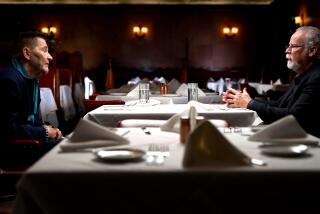Murders All Dolled Up for Detectives : Education: Graphic crime scenes are depicted with tiny plaster people in dollhouses to teach police about crime-solving. All they have to work with is what they see, along with a bit of written information.
- Share via
BALTIMORE — These are dollhouses no child should ever see.
In one bedroom, a painted plaster man about the size of a finger lies on his back in a miniature bed, a shotgun on the floor. The dresser and mirror are spattered with blood.
In a parlor, a woman with yarn hair and a yellow dress lies face down, a tiny knife in her left side, her head in a pool of blood and a hammer nearby. A package of decomposing meat covered with tiny flies sits on a wooden chair.
These dollhouses of death have stumped some of the best homicide investigators for almost 50 years.
Twice a year, about 40 investigators from as far away as Australia and Hong Kong come to the state medical examiner’s office in Baltimore to try to solve the 18 graphic scenes in the wooden, foot-high rooms. All they have to work with is what they can see, along with a bit of written information.
It’s called the Nutshell Studies, built in the 1940s by a New Hampshire state police captain with a fondness for forensic science. Frances Glessner Lee based the scenes on police reports and eyewitness accounts of real murders.
“She’s got the details down to the exact date on a wall calendar,” said Dr. J. Laron Locke, Maryland’s assistant medical examiner.
The investigators are assigned one of the cases at the beginning of their weeklong visit and are expected to figure out whodunit by the end.
Det. Dave Gamble of the prosecutor’s office in Monmouth County, N.J., was assigned a three-room dollhouse with a man and a woman dead in a bedroom and a baby dead in the next room.
At first glance, it appeared that someone had broken into the house and killed all three.
But Gamble thought otherwise: “There was gunshot in the kitchen wall,” he said.
As it turned out, the husband killed the baby, then his wife, then himself.
“You have to dig and really look into them,” said Officer Charles McCully, a homicide investigator for the Metro Dade Police Department in Miami, who participated in the May seminar. “You see some of the crazy things that people do.”
The Nutshell Series was once part of Harvard University Medical School’s Department of Legal Medicine, which Lee endowed. When she died, the department was eliminated. The Nutshell Studies moved to Baltimore in the 1960s.
Since then, the seminars have grown. They now include lectures on new technology, such as DNA testing, and refresher courses on homicide investigation.
The crime solutions are well guarded. But investigators did divulge the clues that helped solve the slaying of the man in the bedroom and the woman in the parlor.
The man’s wife had claimed that he killed himself, but investigators say it was murder because the shotgun lies on the floor, not next to him in bed.
In the scene with the woman on the floor, it’s clear she was kept alive, possibly tortured, for a couple of days because the hamburger meat she left out has decomposed while her body has not.
More to Read
Sign up for Essential California
The most important California stories and recommendations in your inbox every morning.
You may occasionally receive promotional content from the Los Angeles Times.













